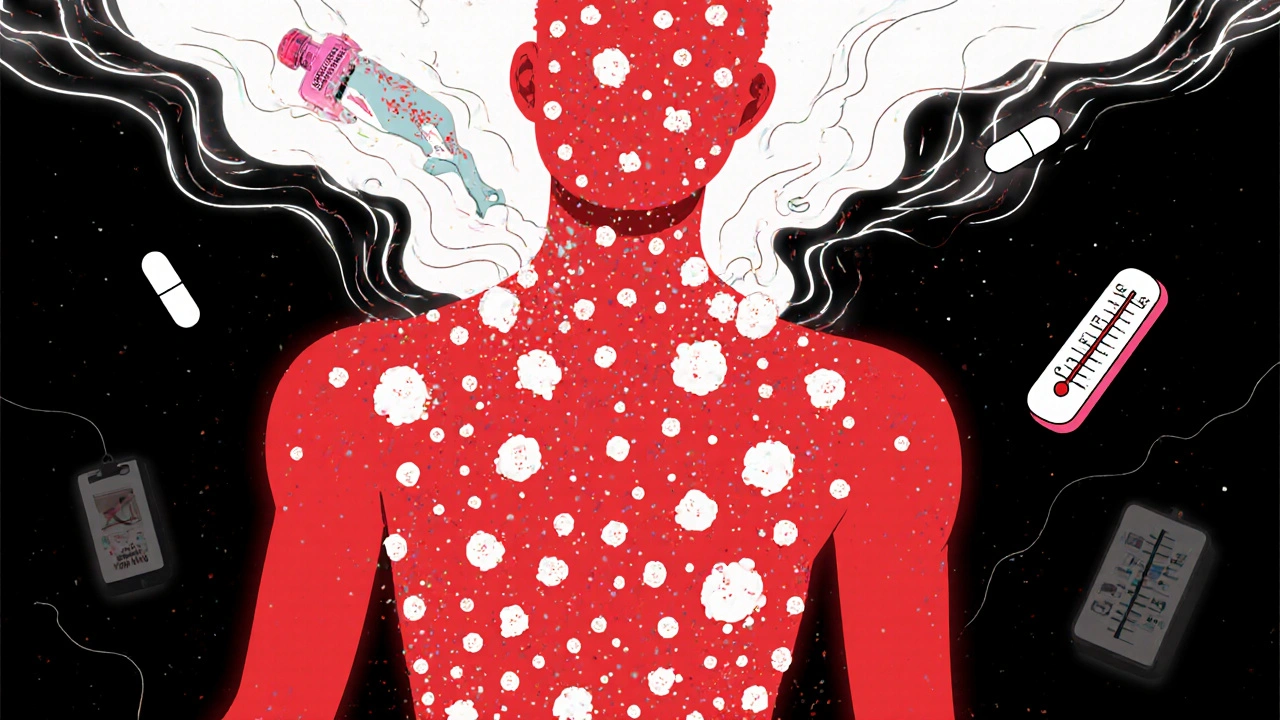Drug Rash: What It Is, How It Happens, and What to Do
When your skin breaks out after taking a new medicine, it’s not always just a coincidence. A drug rash, a skin reaction triggered by medication. Also known as medication-induced rash, it can range from mild redness to life-threatening blistering. Unlike regular side effects like nausea or drowsiness, a drug rash is your body’s immune system reacting to the drug as if it’s an invader. This isn’t just annoying—it’s a warning sign that needs attention.
Not all rashes from meds are the same. Some are harmless and fade when you stop the drug. Others, like Stevens-Johnson syndrome or toxic epidermal necrolysis, can destroy skin and mucous membranes. You might see flat red spots, raised bumps, or blisters. Sometimes it itches. Sometimes it burns. And sometimes, it’s the only clue you have that something inside your body is going wrong. That’s why confusing a drug rash with a regular side effect is dangerous. People often say, "I’m allergic to penicillin," when they just had a rash years ago—and end up stuck with costlier, less effective drugs because no one tested them properly. allergic drug reaction, a true immune response to a medication needs to be confirmed with testing, not assumed.
Many of the medicines linked to rashes are common: antibiotics like penicillin and sulfa drugs, seizure meds like phenytoin, and pain relievers like ibuprofen or naproxen. Even antidepressants and blood pressure pills can trigger them. And here’s the twist: you might take a drug for months without issue, then suddenly react. No one knows why it happens to some people and not others. Genetics, existing health conditions, and even how your liver processes the drug play a role. That’s why medication side effects, expected, non-immune reactions to a drug need to be clearly separated from true allergies. One is predictable and usually mild. The other can be unpredictable and deadly.
If you get a rash after starting a new drug, don’t wait. Stop the medicine if it’s safe to do so—and call your doctor. Take a photo. Note when it started, what it looks like, and whether you have fever, swelling, or trouble breathing. Those details help your doctor decide if it’s a simple reaction or something worse. Many people never get tested, so they avoid entire drug classes for the rest of their lives. But with proper drug allergy testing, medical evaluation to confirm or rule out a true drug allergy, you might find you can safely use the drug again—or find a better alternative.
The posts below give you real-world insights: how to spot the difference between a harmless irritation and a serious reaction, what drugs are most likely to cause trouble, how to talk to your doctor about past rashes, and what steps to take if you’ve been mislabeled as allergic. You’ll find stories from people who thought they were allergic to penicillin—until they got tested. You’ll learn how double dosing or mixing meds can trigger rashes you didn’t expect. And you’ll see how common it is for side effects to be mistaken for allergies, leading to worse outcomes. This isn’t just about skin. It’s about making smarter choices with your meds—and keeping yourself safe.
Acute Generalized Exanthematous Pustulosis (AGEP): What You Need to Know About This Rapid-Onset Drug Rash
AGEP is a rare but serious drug rash that causes sudden, widespread pustules on red skin. It requires immediate discontinuation of the triggering medication and often resolves within two weeks. Learn the signs, causes, and treatment options.
More
